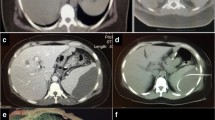Abstract
Five patients underwent an aortobifemoral by-pass using a laparoscope-assisted procedure. With the help of a wall-lifting device, balloon dissection of the retroperitoneum was performed. A total number of five ports were inserted and the aorta was dissected out from the bifurcation to the renal arteries under the guidance of a laparoscopic video camera. A 5-cm incision was required for suturing the proximal anastomosis of the bifurcated graft. Tunneling from the groin to the aorta was performed either video-assisted or with the help of the balloon dissector with a camera inside. All patients could be fully mobilized on the first postoperative day and were discharged after a mean hospital stay of 7.6 days. Mean length of the operation was 250 min. Originally, seven patients were scheduled for the video-assisted procedure. In two cases, we had to change to a conventional technique: in one case because we could not achieve adequate exposure of the aorta in an obese patient using a transperitoneal access, and in the second case owing to extensive adhesions after a bowel resection. Both patients had a regular, uneventful postoperative course. Gasless laparoscopy allowed us to use standard surgical instruments and most importantly a regular aortic clamp, which proved to be beneficial in a heavily calcified aorta. In conclusion, retroperitoneal gasless laparoscopic procedures can be safely performed in infrarenal aortoiliac reconstructions. Further clinical studies are required to prove the usefulness of this new technique.
Zusammenfassung
Die Entwicklung neuerer laparoskopischer Verfahren ermöglicht es, videoassistierte Techniken in der Gefäßchirurgie anzuwenden. Insgesamt wurden 5 Patienten mit Verschlüssen im Aortoiliakalbereich operiert. In allen Fällen wurden nach seitlicher Lagerung das Retroperitoneum mit einem Ballontrokar unter der Sicht einer Videokamera dargestellt. Die Aorta konnte von der Bifurkation bis zu den Nierenarterien freipäpariert werden. Hierzu wurden insgesamt 5 Trokare benötigt. Auf ein Pneumoperitoneum wurde verzichtet und statt dessen die Bauchdecken mit einem mechanischen Hebearm angehoben. In allen Fällen wurden ein aortobifemoraler Bypass (AFB) angelegt. Eine laterale Trokareinstichstelle wurde zu einer Minilaparotomie mit einer Inzisionslägen von 5 cm erweitert. Hierdurch ließ sich die proximale Anastomose mit konventionellen Instrumenten anfertigen, und die Aorta konnte mit einer normalen Aortenklemme abgeklemmt werden. Die Tunnelierung von der Leiste aus erfolgte unter Sicht z. T. auch mit Hilfe eines Ballontrokars. Die mittlere Operationsdauer lag bei 250 min und somit deutlich über der Zeit, die sonst für einen extraperitonealen AFB benötigt wird. Alle Patienten konnten ab dem 1. postoperativen Tag entlassen werden. Der mittlere Krankenhausaufenthalt lag bei 7,6 Tagen. Ursprünglich sollten 7 Patienten mit Hilfe der geschilderten laparoskopisch assistierten Technik operiert werden. In 2 Fällen mußte jedoch auf ein konventionelles Vorgehen übergegangen werden, da sich, bedingt durch technische Schwierigkeiten, die retroperitonealen Strukturen nicht übersichtlich darstellen ließen. Die geschilderten klinischen Ergebnisse zeigen, daß es möglich ist, durch den Einsatz videoassistierter Techniken das Operationstrauma nach aortoiliakalen Eingriffen zu verringern. Weitere kontrollierte Studien müssen zeigen, ob die laparoskopische Technik dem Patienten einen Vorteil bietet.
Similar content being viewed by others
Literatur
Ahn SS, Clem M, Braithwaite MA (1995) Laparoscopic aortofemoral bypass. Ann Surg 5: 677–6838
Berens E, Herde J (1995) Laparoscopic vascular surgery: four case reports. J Vasc Surg 22: 73–79
Biedermann H, Janetschek G, Flora G (1994) Videokontrollierte, retroperitoneoskopische, lumbale Sympathektomie. Chirurg 65: 717–720
Dion Y-M, Karkhouda N, Rouleau C (1993) Laparoscopy-assisted aortobifemoral bypass. Surg Laparosc Endosc 3: 425–429
Dulucq JL (1994) Laparoscopic iliofemoral bypass. Surg Endosc 8: 438
Gaur DD (1992) Laparoscopic operative retroperitoneoscopy: use of a new device. J Urolog 148: 1137
Palmaz JC (1992) Stenting of the iliac arteries with the Palmaz stent: experience from a multicenter trial. Cardiovasc Intervent Radiol 15: 291–297
Weber G, Strauss A, Jako G (1995) Videokontrollierte minimalinvasive Freilegung der Bauchaorta bei aortoiliakalen Rekonstruktionen. Chirurg 66: 146–150
Author information
Authors and Affiliations
Corresponding author
Rights and permissions
About this article
Cite this article
Kolvenbach, R., Deling, O. & Wellmann, K. Laparoskopisch assistierte aortoiliakale Rekonstruktionen. Langenbecks Arch Chiv 382, 119–122 (1997). https://doi.org/10.1007/BF02498661
Received:
Issue Date:
DOI: https://doi.org/10.1007/BF02498661




